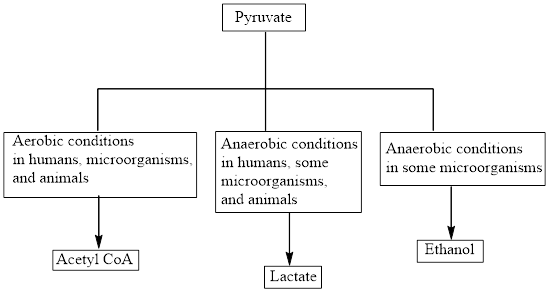
Concept explainers
(a)
Interpretation: To identify acetaldehyde is an intermediate in which the fate of pyruvate-
Concept introduction: Pyruvate is the end product in the glycolysis. The production of the fate of pyruvate varies with the nature of the organism and the cellular conditions. The common fates of pyruvate are as follows:

Aerobic reactions need oxygen while anaerobic reactions don’t need oxygen. Pyruvate forms
An intermediate is defined as the transient species that is formed from the reactants in the preceding step and gets consumed in the subsequent steps to generate the products. An intermediate is formed within a multi-step reaction mechanism.
(a)
Answer to Problem 13.46EP
Acetaldehyde is an intermediate in the formation of ethanol.
Explanation of Solution
Reason for correct choice:
In the ethanol fermentation process, pyruvate is converted to ethanol and carbon dioxide

In step 2, acetaldehyde is reduced to ethanol by alcohol dehydrogenase enzymes.
The chemical reaction is as follows:

The ethanol fermentation equation is as follows:
Therefore, acetaldehyde is formed as an intermediate in the fermentation of ethanol.
Reason for incorrect choice:
The reaction equation for the conversion of pyruvate to
Acetaldehyde is not involved in the oxidation of pyruvate to
The chemical equation for the formation of lactate is as follows:
Acetaldehyde is not involved in lactate fermentation.
(b)
Interpretation: To identify NADH is a product in which fate of pyruvate-
Concept introduction: Pyruvate is the end product in the glycolysis. The production of the fate of pyruvate varies with the nature of the organism and the cellular conditions. The common fates of pyruvate are as follows:

Aerobic reactions need oxygen while anaerobic reactions don’t need oxygen. Pyruvate forms
Nicotinamide adenine dinucleotide is associated with the
(b)
Answer to Problem 13.46EP
NADH is formed along with
Explanation of Solution
Reason for correct choice:
Under aerobic conditions, pyruvate is converted to
Therefore, NADH is formed along with
Reason for incorrect choice:
The ethanol fermentation equation is as follows:
NADH is encountered as a reactant in the fermentation of ethanol.
The lactate fermentation equation is as follows:
NADH is encountered as a reactant in lactate fermentation.
(c)
Interpretation: To identify
Concept introduction: Pyruvate is the end product in the glycolysis. The production of the fate of pyruvate varies with the nature of the organism and the cellular conditions.
The common fates of pyruvate are as follows:

Aerobic reactions need oxygen while anaerobic reactions don’t need oxygen. Pyruvate forms
Nicotinamide adenine dinucleotide is associated with the redox reactions in metabolism. Its reduced form is NADH and oxidized form is
(c)
Answer to Problem 13.46EP
Explanation of Solution
Reason for correct choice:
In the absence of oxygen, pyruvate is converted to lactate by lactate dehydrogenase enzymes in the human body. In this reaction, NADH is oxidized to
The ethanol fermentation equation is as follows:
Reason for incorrect choice:
The overall reaction equation for the conversion of pyruvate to
NADH is formed along with
(d)
Interpretation: To identify the end product is a
Concept introduction: Pyruvate is the end product in the glycolysis. The production of the fate of pyruvate varies with the nature of the organism and the cellular conditions. The common fates of pyruvate are as follows:

Aerobic reactions need oxygen while anaerobic reactions don’t need oxygen. Pyruvate forms
Pyruvate
(d)
Answer to Problem 13.46EP
The end product of the ethanol fermentation is
Explanation of Solution
Reason for correct choice:
In the ethanol fermentation process, pyruvate is converted to ethanol and carbon dioxide by enzymes under the anaerobic conditions. The process of ethanol fermentation takes place in two steps. In step 1, the pyruvate molecule is converted to acetaldehyde by pyruvate decarboxylase enzymes. Carbon dioxide molecule is produced in this step. The chemical reaction is as follows:

In step 2, acetaldehyde is reduced to ethanol by alcohol dehydrogenase enzymes. The chemical reaction is as follows:

The ethanol fermentation equation is as follows:
Ethanol
Pyruvate is converted to

Acetyl group
Reason for incorrect choice:
The chemical reaction for the formation of lactate is as follows:

Lactate contains three carbon atoms. Therefore, lactate is a
Want to see more full solutions like this?
Chapter 13 Solutions
Organic And Biological Chemistry
 General, Organic, and Biological ChemistryChemistryISBN:9781285853918Author:H. Stephen StokerPublisher:Cengage Learning
General, Organic, and Biological ChemistryChemistryISBN:9781285853918Author:H. Stephen StokerPublisher:Cengage Learning Organic And Biological ChemistryChemistryISBN:9781305081079Author:STOKER, H. Stephen (howard Stephen)Publisher:Cengage Learning,
Organic And Biological ChemistryChemistryISBN:9781305081079Author:STOKER, H. Stephen (howard Stephen)Publisher:Cengage Learning, Chemistry for Today: General, Organic, and Bioche...ChemistryISBN:9781305960060Author:Spencer L. Seager, Michael R. Slabaugh, Maren S. HansenPublisher:Cengage Learning
Chemistry for Today: General, Organic, and Bioche...ChemistryISBN:9781305960060Author:Spencer L. Seager, Michael R. Slabaugh, Maren S. HansenPublisher:Cengage Learning


